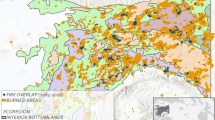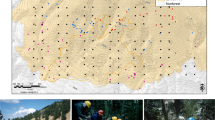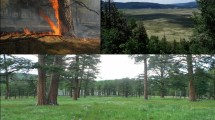Abstract
Forest fires are controlled by local (vegetation, aspect, elevation, land uses) and regional (climate) factors. The role of these factors remains poorly assessed on centennial to millennial time scales. Here, we investigate fire and vegetation history in five subalpine sites over the past 8000 years to determine when, how, and why there were differences in fire regimes. We focus on time and aspect separately and account for vegetation composition. There are no significant differences in the fire return intervals among sites (~290 years between two fires). The rise of fire frequency from its lowest values (1.5 fires.1000 yr−1) at 8000–7000 years before present (yrBP) to its highest at 4000-3000 yrBP (5 fires-1000 yr−1) is well explained by the high temperatures and low precipitation of the Holocene, both leading to better conditions for fire ignition and spread. From 8000 yrBP, climate is likely the main factor driving the fire frequency on the north-facing sites, which contained mixed Larix decidua-Pinus cembra vegetation; whereas south-facing sites, dominated by the flammable P. cembra and broadleaved trees, appear to be driven by local features, including land use. A shift in the main drivers occurs at 4000 yrBP, when local processes start to control burning activity at all sites. Forest clearance for land use might have directly increased fire frequency, but has also helped to suppress fires through fuel limitation. During the last four millennia, land use likely altered the natural climate-vegetation-fire system mainly by converting forests to grassland by pastoral practices, thus leading to less fire and making the fire-vegetation-climate relationships more complex.



Similar content being viewed by others
References
Aleman JC, Blarquez O, Bentaleb I, et al. (2013) Tracking land-cover changes with sedimentary charcoal in the Afrotropics. The Holocene 23:1853–1862
Bauer DF (1972) Constructing confidence sets using rank statistics. J Am Stat Assoc:687–690
Birks HH (2003) The importance of plant macrofossils in the reconstruction of lateglacial vegetation and climate: examples from Scotland, western Norway, and Minnesota, USA. Quat Sci Rev 22:453–473
Blarquez O, Bremond L, Carcaillet C (2010a) Holocene fires and a herb-dominated understorey track wetter climates in subalpine forests. J Ecol 98:1358–1368. doi:10.1111/j.1365-2745.2010.01721.x
Blarquez O, Carcaillet C, Bremond L, et al. (2010b) Trees in the subalpine belt since 11 700 cal. BP: origin, expansion and alteration of the modern forest. The Holocene 20:139–146. doi:10.1177/0959683609348857
Carcaillet C, Ali A, Blarquez O, et al. (2009) Spatial variability of fire history in subalpine forests: from natural to cultural regimes. Ecoscience 16:1–12. doi:10.2980/16-1-3189
Casty C, Wanner H, Luterbacher J, et al. (2005) Temperature and precipitation variability in the European Alps since 1500. Int J Climatol 25:1855–1880. doi:10.1002/joc.1216
Colombaroli D, Henne PD, Kaltenrieder P, et al. (2010) Species responses to fire, climate and human impact at tree line in the Alps as evidenced by palaeo-environmental records and a dynamic simulation model. J Ecol 98:1346–1357. doi:10.1111/j.1365-2745.2010.01723.x
Conedera M, Corti G, Piccini P, et al (2004) Forest fire management in Canton Ticino: attempting a historical overview
Daniau AL, Bartlein PJ, Harrison SP, et al. (2012) Predictability of biomass burning in response to climate changes. Glob Biogeochem Cycles 26:1–12. doi:10.1029/2011GB004249
Duffin KII, Gillson L, Willis KJJ (2008) Testing the sensitivity of charcoal as an indicator of fire events in savanna environments: quantitative predictions of fire proximity, area and intensity. The Holocene 18:279–291. doi:10.1177/0959683607086766
Feurdean A, Liakka J, Vannière B, et al. (2013) 12,000-years of fire regime drivers in the lowlands of transylvania (Central-Eastern Europe): a data-model approach. Quat Sci Rev 81:48–61. doi:10.1016/j.quascirev.2013.09.014
Fréjaville T, Curt T (2015) Spatiotemporal patterns of changes in fire regime and climate: defining the pyroclimates of south-eastern France (Mediterranean Basin). Clim Chang 1–13. doi:10.1007/s10584-015-1332-3
Frejaville T, Curt T, Carcaillet C (2013) Bark flammability as a fire-response trait for subalpine trees. Front Plant Sci. doi:10.3389/fpls.2013.00466
Gavin DG, Hu FS, Lertzman K, et al. (2006) Weak climatic control of stand-scale fire history during the late Holocene. Ecology 87:1722–1732. doi:10.1890/0012-9658(2006)87[1722:WCCOSF]2.0.CO;2
Genries A, Muller SD, Mercier L, et al. (2009) Fires control spatial variability of subalpine vegetation dynamics during the Holocene in the Maurienne valley (French Alps). Ecoscience 16:13–22. doi:10.2980/16-1-3180
Giguet-Covex C, Pansu J, Arnaud F, et al. (2014) Long livestock farming history and human landscape shaping revealed by lake sediment DNA. Nat Commun 5:3211. doi:10.1038/ncomms4211
Gillson L, Marchant R (2014) From myopia to clarity: sharpening the focus of ecosystem management through the lens of palaeoecology. Trends Ecol Evol 29:317–325
Giorgi F, Lionello P (2008) Climate change projections for the Mediterranean region. Glob Planet Change 63:90–104. doi:10.1016/j.gloplacha.2007.09.005
Girardin MP, Ali AA, Carcaillet C, et al. (2013) Vegetation limits the impact of a warm climate on boreal wildfires. New Phytol 199:1001–1011. doi:10.1111/nph.12322
Grime JP (1998) Benefits of plant diversity to ecosystems: immediate, filter and founder effects. J Ecol 86:902–910. doi:10.1046/j.1365-2745.1998.00306.x
Higuera PE, Brubaker LB, Anderson PM, et al. (2009) Vegetation mediated the impacts of postglacial climate change on fire regimes in the south-central Brooks Range, Alaska. Ecol Monogr 79:201–219
Higuera PE, Gavin DG, Bartlein PJ, Hallett DJ (2010) Peak detection in sediment-charcoal records: impacts of alternative data analysis methods on fire-history interpretations. Int J Wildl Fire 19:996–1014. doi:10.1071/WF09134
Jensen K, Lynch EA, Calcote R, Hotchkiss SC (2007) Interpretation of charcoal morphotypes in sediments from Ferry Lake, Wisconsin, USA: do different plant fuel sources produce distinctive charcoal morphotypes? The Holocene 17:907
Keller F, Lischke H, Mathis T, et al. (2002) Effects of climate, fire, and humans on forest dynamics: forest simulations compared to the palaeological record. Ecol Model 152:109–127. doi:10.1016/S0304-3800(02)00011-X
Kelly RF, Higuera PE, Barrett CM, Hu FS (2011) A signal-to-noise index to quantify the potential for peak detection in sediment-charcoal records. Quat Res 75:11–17. doi:10.1016/j.yqres.2010.07.011
Körner C (2003) Alpine plant life: functional plant ecology of high mountain ecosystems; with 47 tables
Leys B, Finsinger W, Carcaillet C (2014) Historical range of fire frequency is not the Achilles’ heel of the Corsican black pine ecosystem. J Ecol 102:381–395. doi:10.1111/1365-2745.12207
Lynch JA, Clark JS, Stocks BJ (2004) Charcoal production, dispersal, and deposition from the Fort Providence experimental fire: interpreting fire regimes from charcoal records in boreal forests. Can J For Res 34:1642–1656
Magri D, Agrillo E, Di Rita F, et al. (2015) Holocene dynamics of tree taxa populations in Italy. Rev Palaeobot Palynol 218:267–284. doi:10.1016/j.revpalbo.2014.08.012
Marsglia G, Tsang WW, Wang J (2003) Evaluating Kolmogorov’s distribution. J Stat Softw 8:1–4
Moritz MA, Batllori E, Bradstock RA, et al. (2014) Learning to coexist with wildfire. Nature 515:58–66
Motta R, Berretti R, Lingua E, Piussi P (2006) Coarse woody debris, forest structure and regeneration in the Valbona Forest Reserve, Paneveggio, Italian Alps. For Ecol Manag 235:155–163. doi:10.1016/j.foreco.2006.08.007
Ortu E, Peyron O, Bordon A, et al. (2008) Lateglacial and Holocene climate oscillations in the South-western Alps: an attempt at quantitative reconstruction. Quat Int 190:71–88. doi:10.1016/j.quaint.2008.04.004
Pausas JG, Fernández-Muñoz S (2012) Fire regime changes in the Western Mediterranean Basin: from fuel-limited to drought-driven fire regime. Clim Chang 110:215–226. doi:10.1007/s10584-011-0060-6
Power MJ, Marlon J, Ortiz N, et al. (2008) Changes in fire regimes since the Last Glacial Maximum: an assessment based on a global synthesis and analysis of charcoal data. Clim Dyn 30:887–907. doi:10.1007/s00382-007-0334-x
Rey PJ, Thirault E (1999) Le peuplement des vallées alpines au Néolithique: les exemples de la Maurienne et de la Tarentaise (Savoie). Circ identites Cult alpines ala fin la Prehistoire Mater pour une etude (programme Collect CIRCALP 1997‚ 1998) 501–518
Rius D, Vannière B, Galop D (2012) Holocene history of fire, vegetation and land use from the central Pyrenees (France). Quat Res 77:54–64. doi:10.1016/j.yqres.2011.09.009
Schwörer C, Colombaroli D, Kaltenrieder P, et al. (2015) Early human impact (5000–3000 BC) affects mountain forest dynamics in the Alps. J Ecol 103:281–295
Tinner W, Ammann B (2005) Long-term responses of mountain ecosystems to environmental changes: resilience, adjustment, and vulnerabilityglobal change and mountain regions. In: Huber UM, Bugmann HKM, Reasoner MA (eds). Springer Netherlands, pp 133–143
Valese E (2007) Wildland fires in the Alpine region of Italy: what’s old, what's new. What’s next 97–101
Van Geel B, Buurman J, Waterbolk HT (1996) Archaeological and palaeoecological indications of an abrupt climate change in The Netherlands, and evidence for climatological teleconnections around 2650 BP. J Quat Sci 11:451–460. doi:10.1002/(SICI)1099-1417(199611/12)11:6<451::AID-JQS275>3.0.CO;2-9
Zumbrunnen T, Bugmann H, Conedera M, et al. (2009) Linking forest fire regimes and climate-a historical analysis in a dry inner Alpine Valley. Ecosystems 12:73–86. doi:10.1007/s10021-008-9207-3
Zumbrunnen T, Menéndez P, Bugmann H, et al. (2012) Human impacts on fire occurrence: a case study of hundred years of forest fires in a dry alpine valley in Switzerland. Reg Environ Chang 12:935–949
Acknowledgments
We thank the three reviewers for their helpful comments on the manuscript. We also thank J. Commerford for her help on the English editing. Financial support was provided by the FIREMAN program (ANR/ERA-net BiodivERsA; Grant: ANR-08-BDVA-0004) and by a PhD grant to BL from the Ecole Pratique des Hautes Etudes (EPHE-Paris).
Author information
Authors and Affiliations
Corresponding author
Rights and permissions
About this article
Cite this article
Leys, B., Carcaillet, C. Subalpine fires: the roles of vegetation, climate and, ultimately, land uses. Climatic Change 135, 683–697 (2016). https://doi.org/10.1007/s10584-016-1594-4
Received:
Accepted:
Published:
Issue Date:
DOI: https://doi.org/10.1007/s10584-016-1594-4




